Introduction to Operating Systems
In this part, we will introduce you to the world of Operating Systems! We will first introduce the 3 major parts of Operating Systems: Virtualization, Concurrency and Persistence, which we will go into the details in later days. Then, we will introduce some basic Operating System interfaces and concepts. At last, we will talk about the OS boot sequence, especially how the OS boot in OS/161.
Introduction to Operating Systems
Learning Materials
Readings:
Short section on booting in The Little Book About OS Development
Lecture Slides:
3 Major Parts of Operating Systems
In this part, we will briefly introduce the 3 major parts of Operating Systems: Virtualization, Concurrency and Persistence.
Virtualization
The crux of the problem:
How does OS virtualize resources?
- Virtualizing the CPU
OS creates an illusion that the system has a very large number of virtual CPUs.
Each running program is represented in the kernel as a process.
Each process has its own state: Program counter, registers, memory, open files, …
A process runs for a while…Then the system is interrupted by a timer interrupt.
The kernel performs a context switch:
Saves the state of the old process to memory
Loads the state of the new process onto the CPU
Let the new process run
After a while, there is another interrupt, and the kernel switches back to the old process.
- Virtualizing Memory
1 | |
output:
1 | |
Each process accesses its own address space, which the OS maps onto the physical memory of the machine. We will talk more about address spaces and how virtual memory is translated into physical memory later.
Virtual memory may be much larger than physical memory.
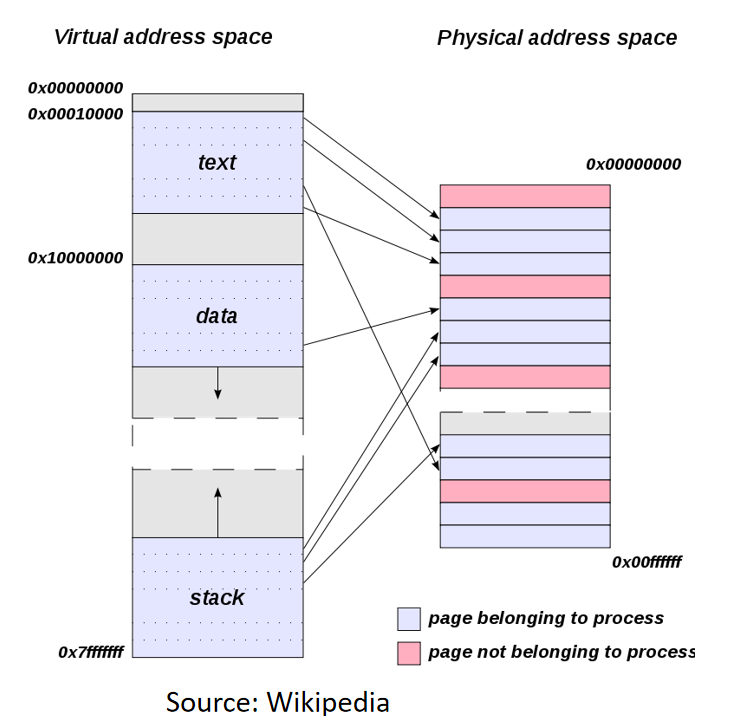
Concurrency
A Multi-threaded Program:
1 | |
output:
1 | |
Each thread increments counter 1000 times
1 | |
What?
Incrementing
countertakes 3 instructions:
One to load the value of the counter from memory into a register, one to increment it, and one to store it back into memory.
These three instructions do not execute atomically.
So it leads to the crux of the problem:
How to build correct concurrent problems?
Persistence
The crux of the problem:
How to store data persistently
The file system is the part of the OS in charge of managing persistent data
Design Goals
Finding the right set of trade-offs is a key to building systems.
Our goals:
-
build up some abstractions
-
provide high performance
provide virtualization and other OS features without excessive overheads (extra time, extra space).
- provide protection between applications
main principles of OS: isolation
-
reliability
-
other: energy-efficiency, security, mobility
Operating System Interfaces
user space and kernel space
A process alternates between executing in user space and kernel space.

shell
An ordinary user program that reads commands from the user and executes them
The primary user interface to traditional Unix-like systems
Processes and memory
fork()
wait()
1 | |
exec(filename, *argv)
1 | |
I/O and File descriptors
The file descriptor interface abstracts away the differences between files, pipes, and devices, making them all look like streams of bytes
- I/O redirection
1 | |
Now it is clear why it is a good idea that fork and exec are separate calls. This separation allows the shell to fix up (e.g. I/O redirection) the child process before the child runs the intended program (exec).
forksystem call
Although fork copies the file descriptor table, each underlying file offset is shared between parent and child.
1 | |
output: "hello world"
dupsystem call
1 | |
output: "hello world"
Pipes
A small kernel buffer exposed to processes as a pair of file descriptors, one for reading and one for writing
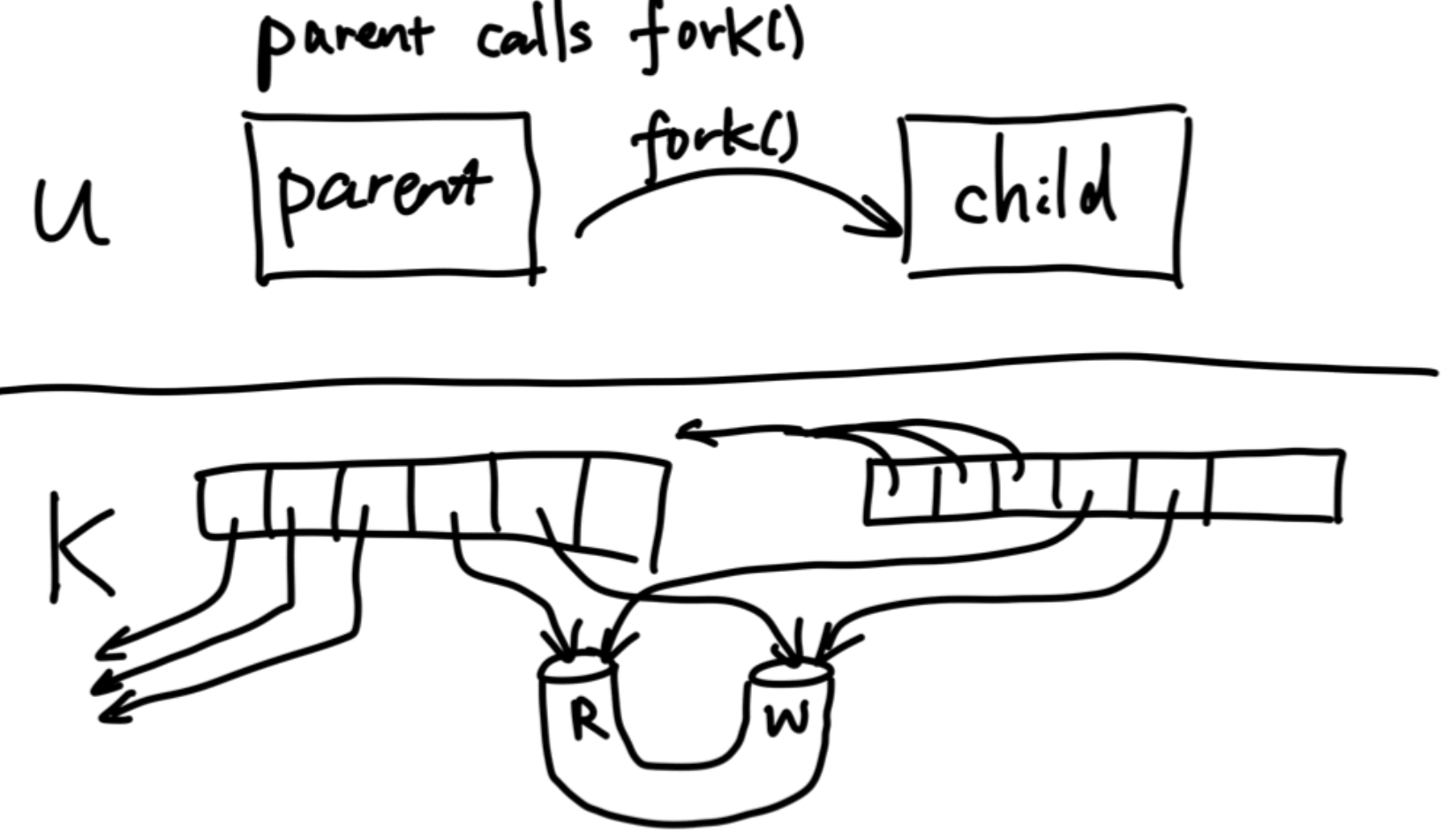
The pipe file is just a memory buffer.
The mechanics of pipe is that it creates a special "pipe" file in memory. Parent process's two file descriptors refer to its vnode: one for reading (pfd[0]), one for writing (pfd[1]). Then the parent process forks a child process, which shares file handles with the parent and can read/write the same pipe. The parent and the child each close one side of the pipe(read/write) and can communicate with each other.
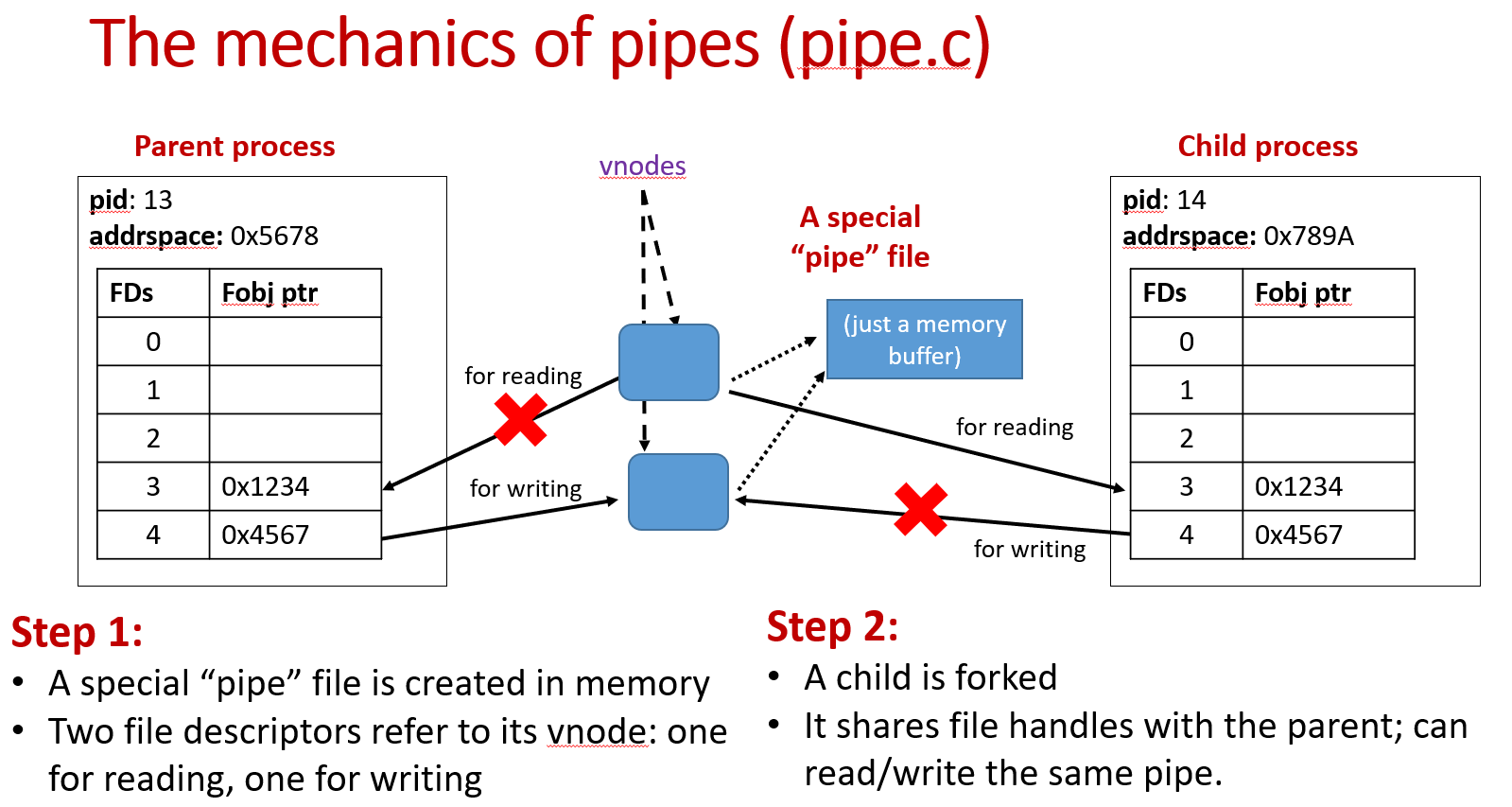
- Redirecting Pipe I/O:
As shown below, parent redirects output end of the pipe (pfd[1]) to STDOUT via the dup2 system call. In this way, whatever the parent is writing to STDOUT can be read by the child from the input end of the pipe (pfd[0]).
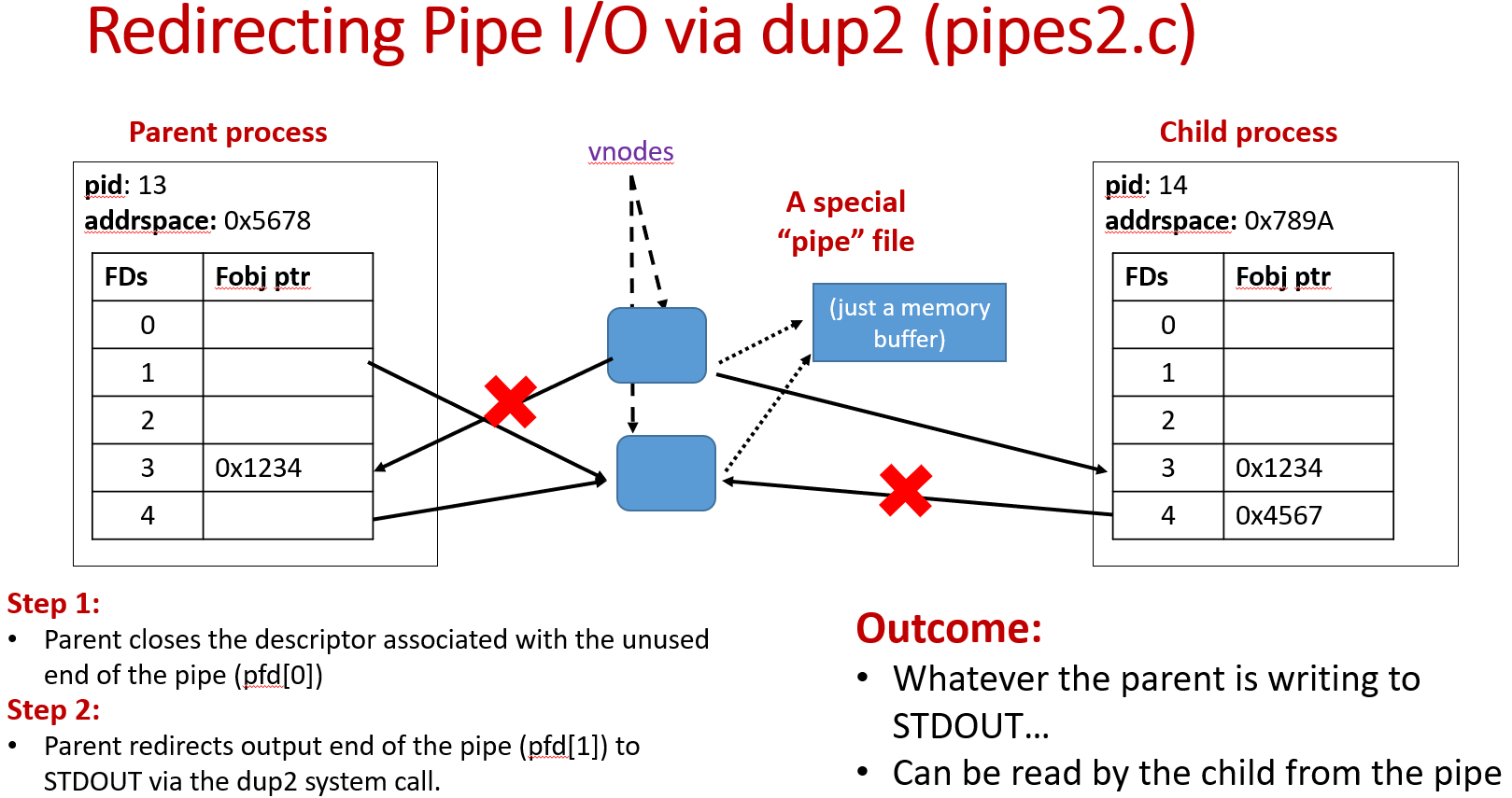
1 | |
The program redirect child process's stdin to the read end of the pipe
p[0] is the read end of the pipe
p[1] is the write end of the pipe
File System
chdirsystem call
They open the same file:
1 | |
O_CREATEflag andmknodsystem call
open with the O_CREATE flag creates a new data file
mknod creates a new device file
1 | |
fstat
fstat retrieves information about the object a file descriptor refers to.
1 | |
linksystem call
The same underlying file, called an inode, can have multiple names, called links,
Create a new file named both a and b:
1 | |
Each inode is identified by a unique inode number
unlinksystem call
Removes a name from the file system
1 | |
1 | |
Traps, Interrupts, and Drivers (in x86)
Systems Calls, Exceptions, and Interrupts
- interrupt
An interrupts stops the normal processor loop and starts executing a new sequence called an interrupt handler
Processor should switch from user mode to kernel mode, and back
- Difference between traps and interrupts
traps are caused by the current process running on a processor (e.g. system call)
interrupts are caused by devices and may not be related to the currently running process
x86 protection
To make a system call on the x86, a program invokes the int n instruction
n specifies the index into the IDT (interrupt descriptor table), representing different types of interrupt
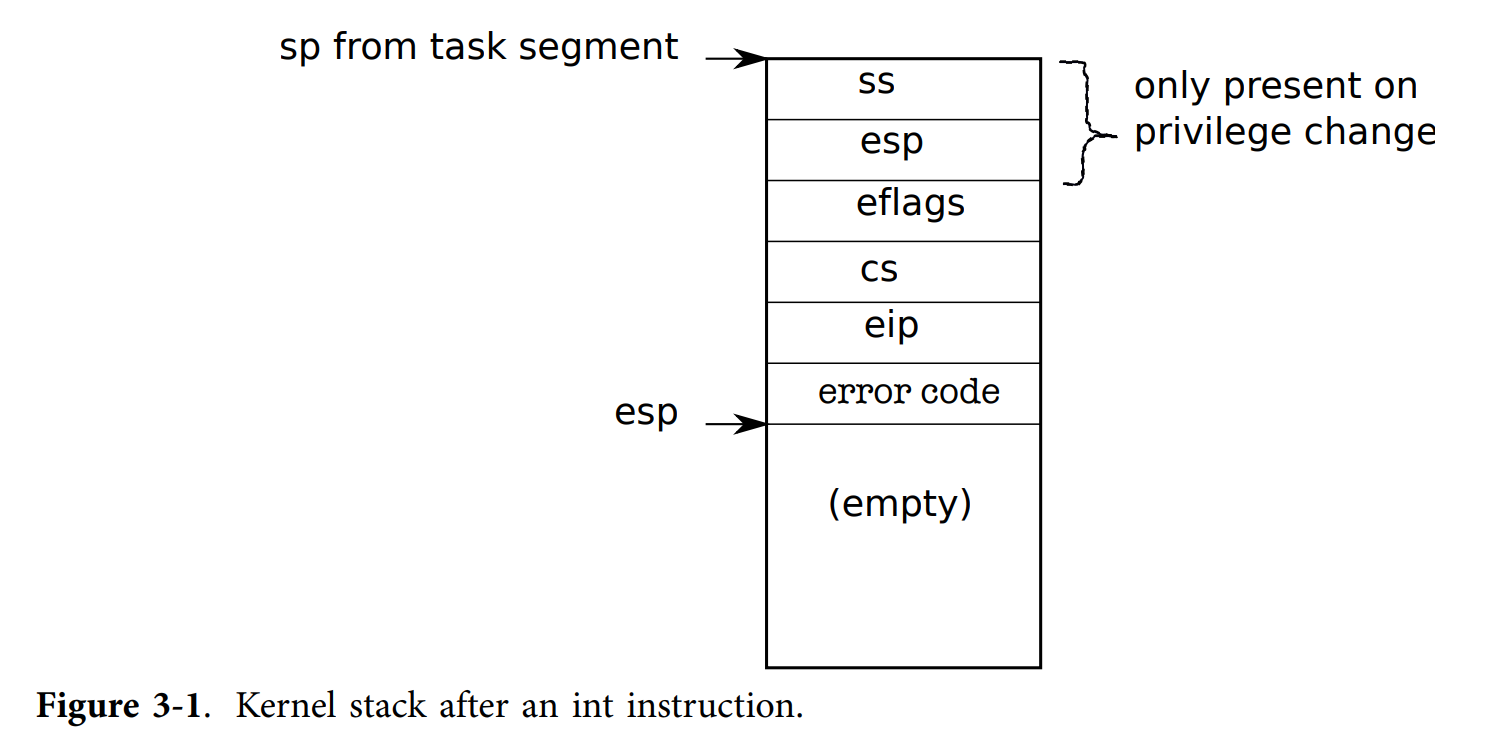
Code: Assembly trap handlers
The user mode processor registers are saved in the trapframe on the kernel stack
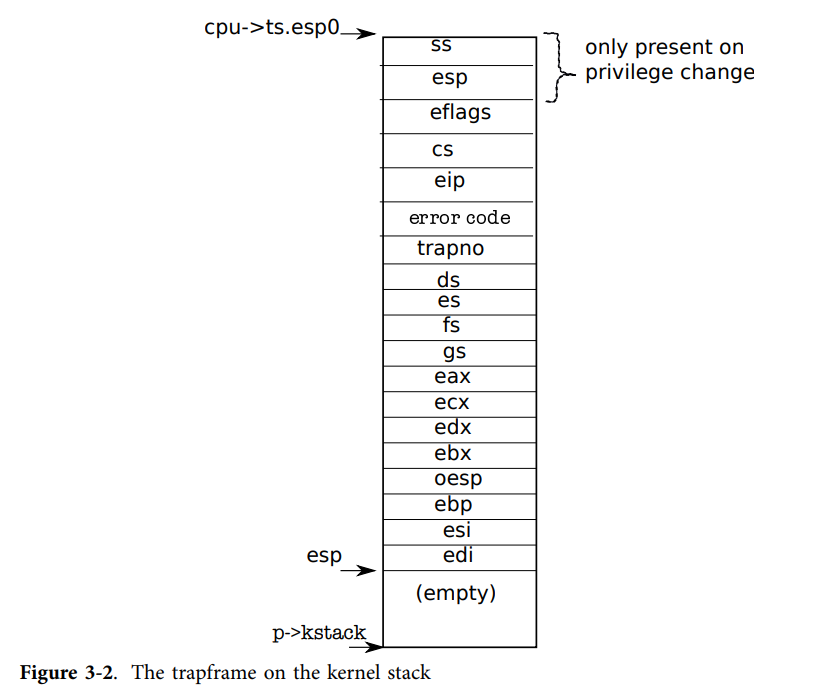
Code: C trap handler
Each handler sets up a trap frame and then calls the C function trap
If the trap is T_SYSCALL, trap calls the system call handler syscall
After checking for a system call, trap looks for hardware interrupts
If the trap is not a system call and not a hardware device looking for attention, trap assumes it was caused by incorrect behavior as part of the code that was executing before the trap
If the code was a user program, clean it up
If it was kernel running, there must be a kernel bug: trap prints details about the surprise and then calls panic.
Code: System Calls
trap invoke syscall
syscall loads the system call number from the trap frame and indexes into the system call table
Code: Interrupts
Can occur at any time
Signal the CPU when a device needs attention
Drivers
A driver manage a particular device: it provides interrupt handlers for a device, causes a device to perform operations, causes a device to generate interrupts, …
Code: Disk driver
- Disk sectors
A numbered sequence of 512-byte blocks
The disk driver represent disk sectors with a data structure called a buffer
Each buffer represents the contents of one sector on a particular disk device
1 | |
Address Space and Address Translation
Address Spaces
- Time sharing
Where the programs actually lives:
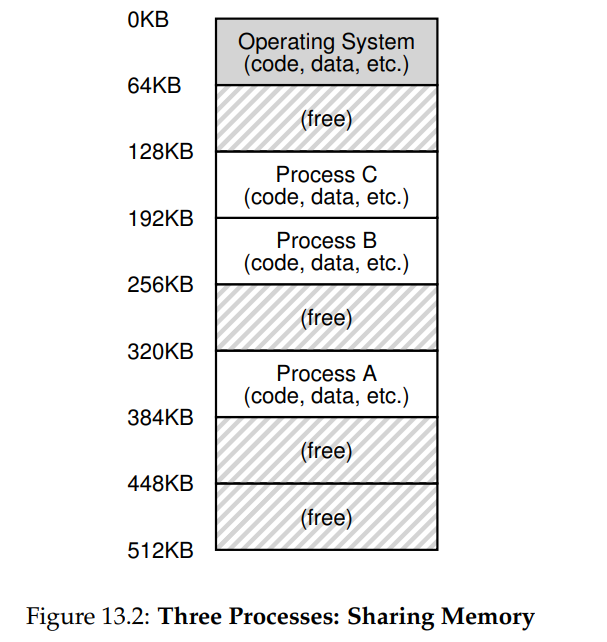
- Address Space
Layout of an user address space:
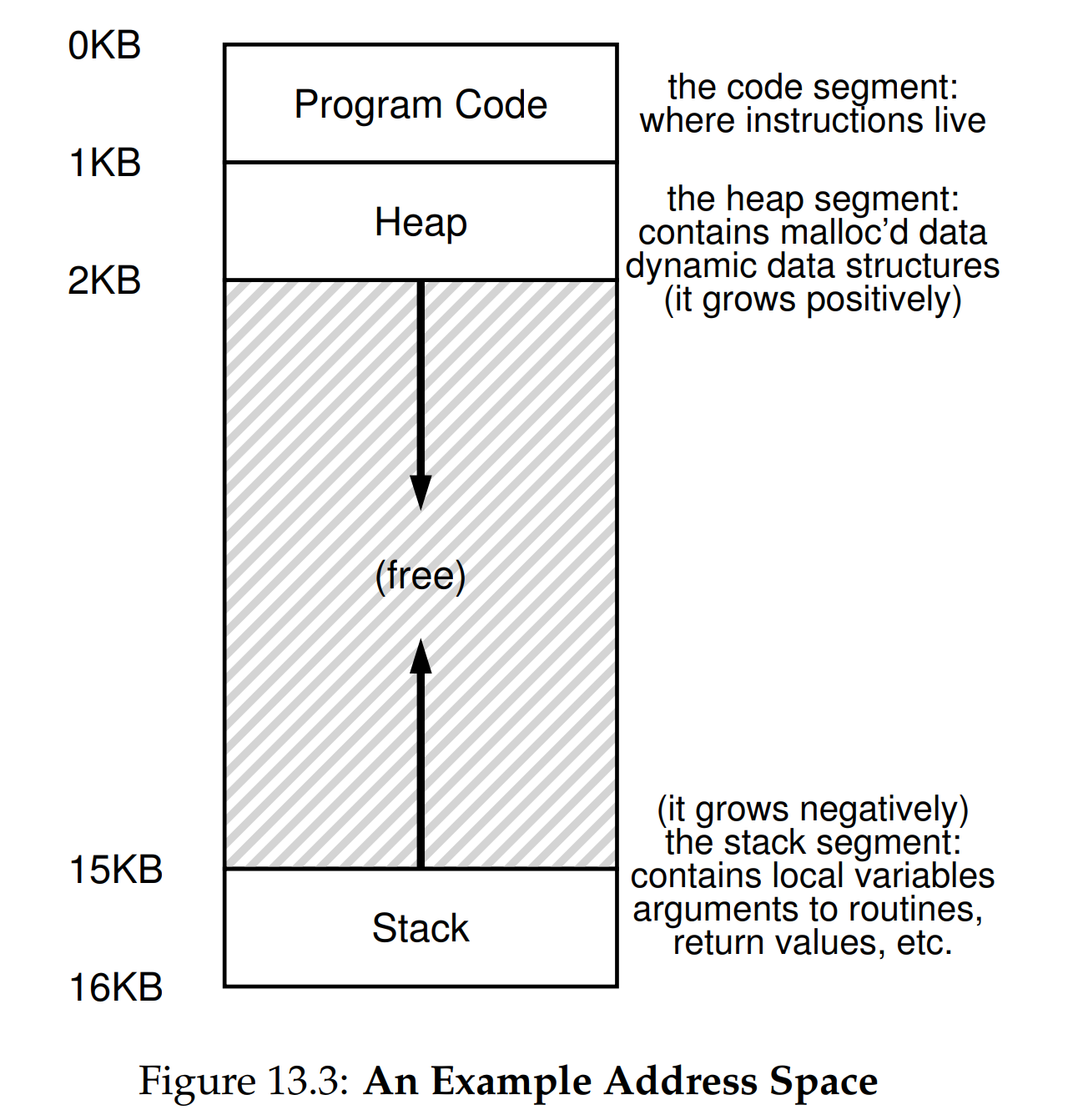
Layout of a virtual address space:
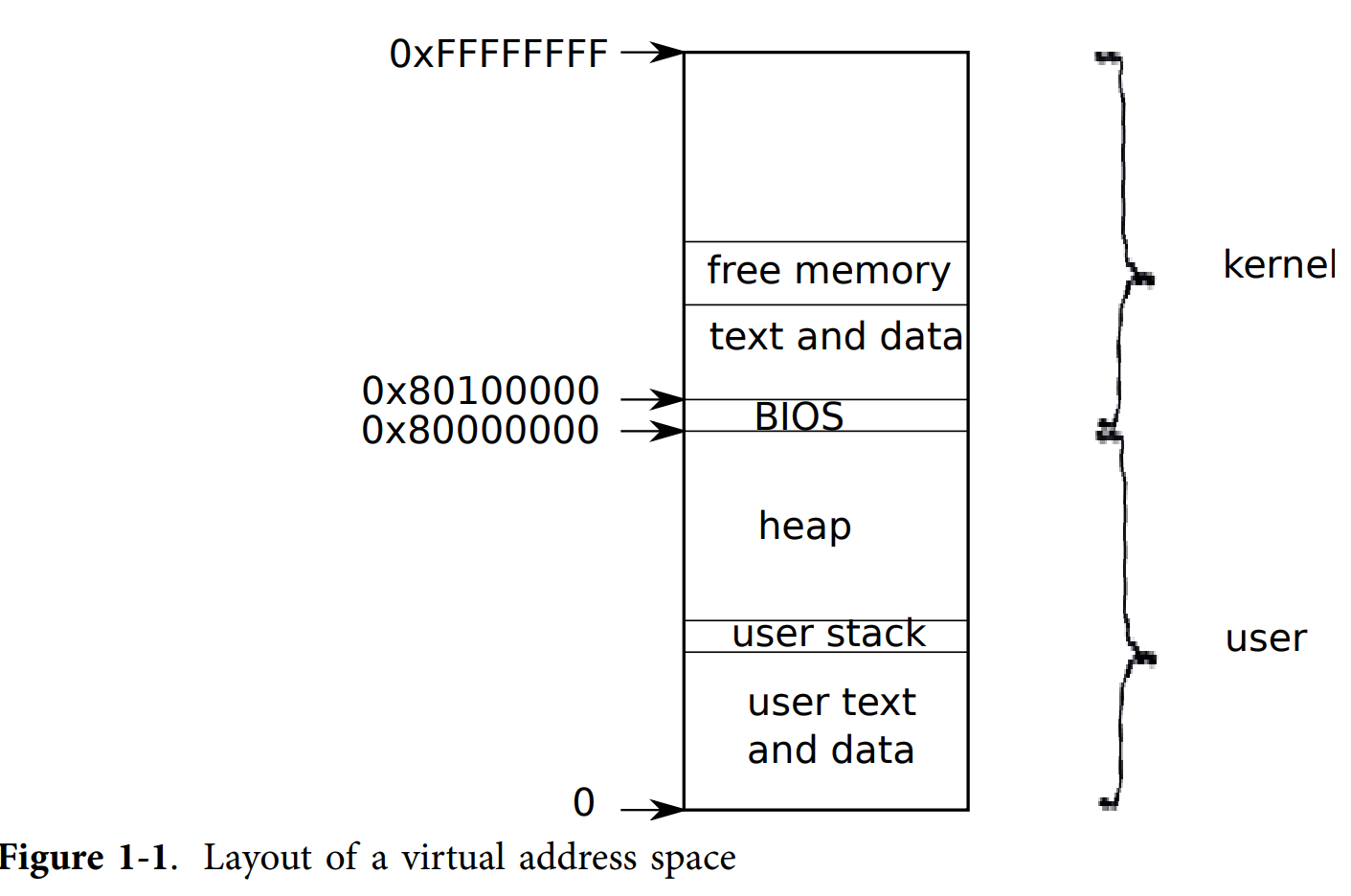
Address Translation
- Dynamic (Hardware-based) Relocation
When a program starts running, the OS decides where in physical memory it should be loaded and sets the base register to that value.
physical address = virtual address + base
base is the process's physical starting address (first instruction)
bounds holds the size of the process's address space to help with protection
- OS Issues
what OS does at boot time (After the kernel is loaded into memory by bootloader):

what happens when a process (Process A) starts running:
Address Translation is done by hardware only, except for exception
when starting a new process A,
allocate entry in process table
allocate memory for process (looking for free memory via
free list)set base/bound registers
return from trap into A
when a context switch occurs,
save regs(A) to proc-struct(A) (including base/bounds, PC…);
restore regs(B) from proc-struct(B) (including base/bounds, PC…)
return from trap into B
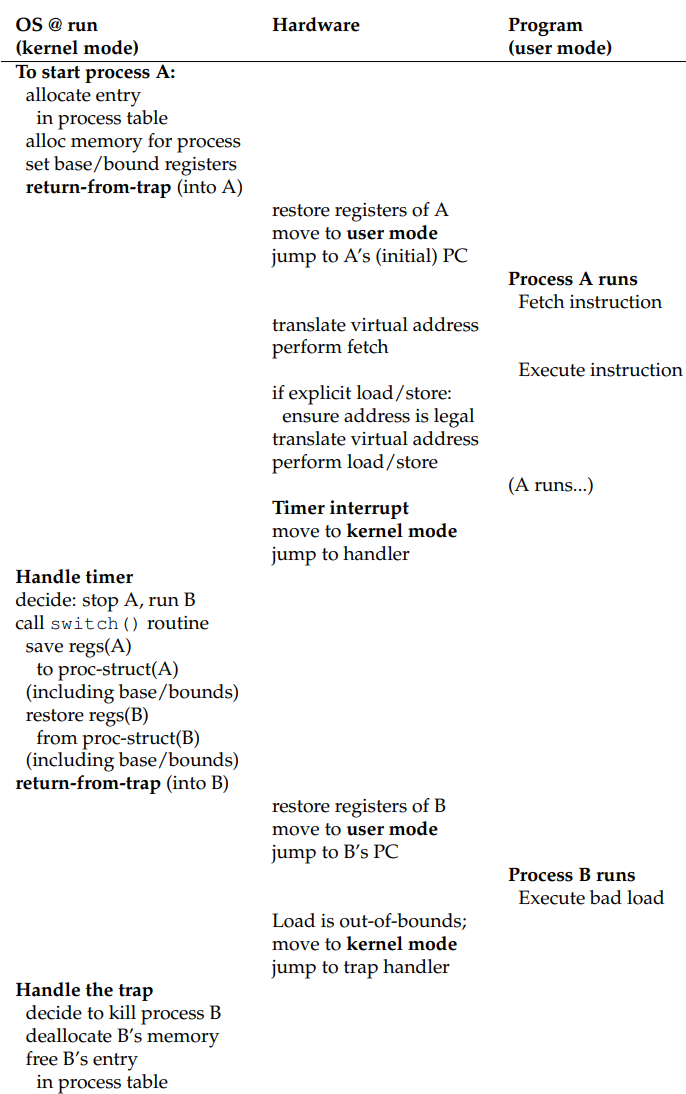
OS Booting
General booting sequence
Booting an operating system consists of transferring control along a chain of small programs
An example of the boot process. Each box is a program:

- BIOS
Today, BIOS mainly runs some early diagnostics (power-on-self-test) and then transfers control to the bootloader.
- The Bootloader
task: transfer control to the operating system
Using GRUB, the OS can be built as an ordinary ELF executable, which will be loaded by GRUB into the correct memory location.
- Kernel ELF Information
Entry point address: where CPU executes the first instruction after the kernel is loaded into memory by the bootloader.
In OS161:
1 | |
How does the OS boot in OS161?
Q: Where does the processor expect to find the very first instruction to run, after it is powered on?
We first need to know the design of MIPS processors.
- MIPS processors
Physical Memory MIPS assumes:

Virtual Memory MIPS assumes:
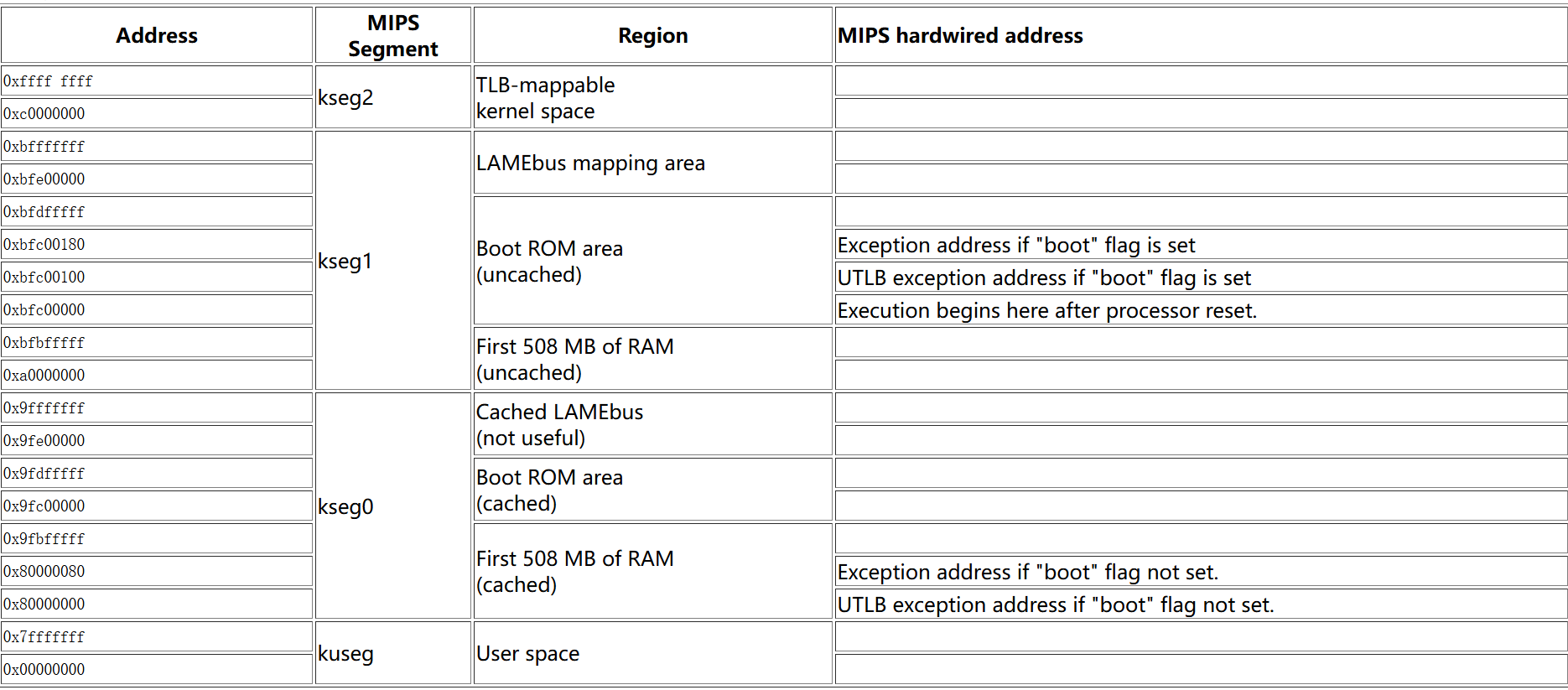
Boot ROM area is where the bootloader lives. So 0xbfc00000 is where the very first instruction to run. Namely, after the processor is powered on, the bootloader runs first.
kernel area:

Draw a diagram showing how kseg0 and kseg1 map to the same physical memory area:
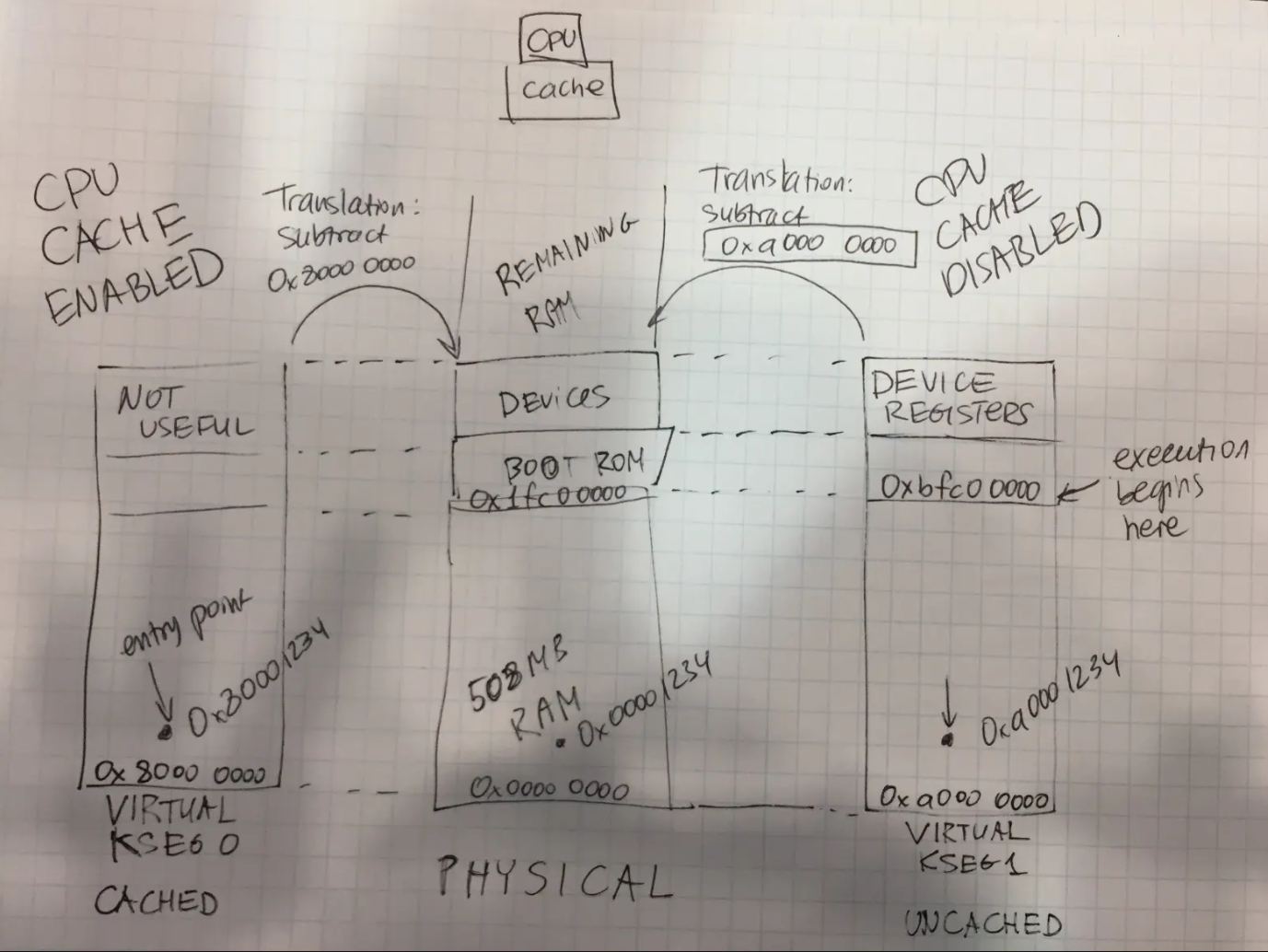
Q: Based on that, can you tell what is the maximum amount of virtual memory that a user program can use?
2G
Q: What is an exception address and why is it critical for the boot sequence? Where does the hardware expect to find exception code AFTER we boot (boot flag not set)?
Exception Address refers to a specific memory location where the processor jumps to when an exception or interrupt occurs.
After we boot up, boot flag is no longer set, we find exception code in kernel area(0x80000000 and 0x80000080)
Look at os161 source code:
Begin with main.c -- it is located in ~/os161/src/kern/main/main.c.
Look at the boot() function. In particular, trace all the way through ram_bootstrap(). Find the lowest-level function that reads the size of the RAM from the hardware:
1 | |
Take a look at ~/os161/src/kern/arch/sys161/main/start.S. Since we are running on the simulator, the early boot code is located not in the boot ROM, but in sys161 -- the hardware simulator. The code in start.S is the very first code that runs on the system! It sets up the operating system to run and gives you the idea of what the actual boot ROM code looks like.
Note that the code in start.S is executed by the hardware simulator and it serves the same purpose as the actual bootloader.
Q: How does
kmain()get called?
1 | |
1 | |
To sum up, after the MIPS processor is powered on, it starts executing the code in start.S, which is executed by the sys161 hardware simulator to serve the purpose of the bootloader. The code in start.S, or the bootloader, initialize hardware and load the kernel into memory (including copy the exception handlers to specific memory locations), then transfer controls to the kernel entry point (kmain).